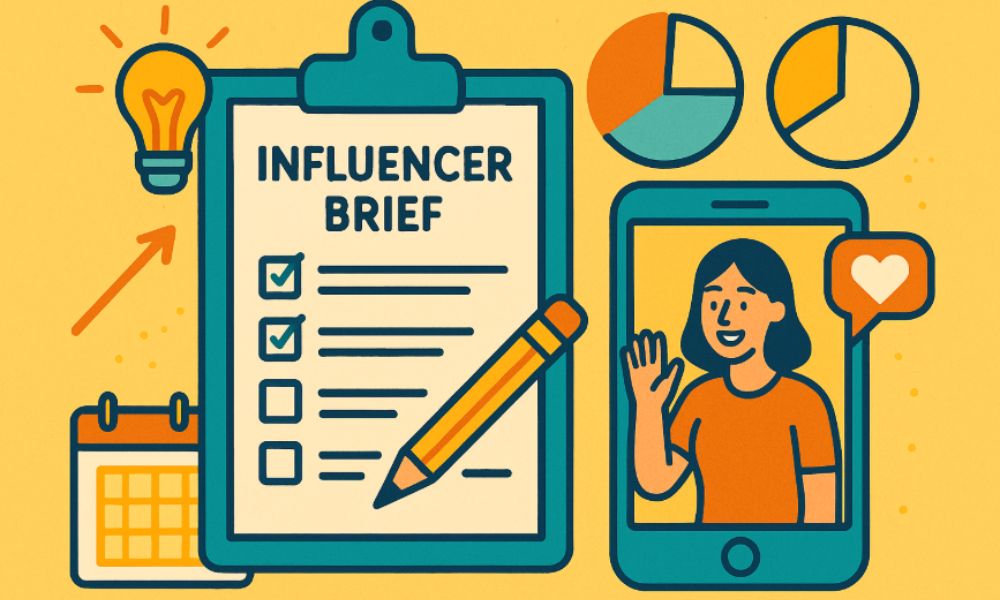
Picture this: you’ve just spent weeks securing the right creators for your campaign. You’re excited to see the first pieces of content roll in. But then it happens, the influencer brief you sent was a 20-page PDF stuffed with product specs, hashtags, and legal disclaimers. The result? Creators feel boxed in, the content falls flat, and engagement tanks.
I’ve seen brands pour tens of thousands into influencer partnerships, only to watch their content land with the enthusiasm of a Monday morning meeting. The culprit? A bloated brief that either gets ignored, or worse, smothers authenticity before the campaign even begins.
After thousands of influencer collaborations, one thing has become clear: authenticity is the only currency that matters in influencer marketing. And nothing kills authenticity faster than over-engineering every detail of the creative process.
We’ve tested everything: fifty-slide corporate presentations, single-line bullet points, and everything in between. The clear winner? A simple, strategic one-page influencer brief that gives creators guidance without strangling their voice. Let me walk you through why this works, and more importantly, how to do it right.
What Is an Influencer Brief and Why Is It Important?
An influencer brief is a short document that gives creators the essential information they need to run your campaign successfully. Think of it as a roadmap: it outlines your brand’s goals, the key message you want to communicate, and any must-have details (like links, hashtags, or disclaimers).
Why does this matter? Because without it, campaigns drift. Creators might miss the main message, focus on the wrong features, or deliver content that doesn’t align with your goals. On the other hand, a clear influencer brief sets everyone up for success, it keeps creators focused while still giving them space to bring their own voice and style.
I’ve seen the difference firsthand. Some brands try to cover everything, sending fifty-slide decks that feel more like training manuals. Others go too far the other way, tossing over a single vague sentence. Neither works. The best results always come from a simple, strategic brief that cuts through the noise and gives creators exactly what they need, nothing more, nothing less.
That’s why influencer briefs are important: they save time, reduce miscommunication, and unlock the authenticity that makes influencer marketing work in the first place.
Key Components of a Strong Influencer Brief
A good influencer brief doesn’t need to be long, but it does need to be clear. After running hundreds of campaigns, I’ve learned that the best briefs cover five essentials, just enough to guide creators without overwhelming them.
1. Campaign Overview & Goals
Start by giving influencers the bigger picture. What is this campaign about, and what are you trying to achieve? Whether it’s brand awareness, driving traffic, or boosting conversions, your campaign goal should be easy to spot within the first few lines. A clear “north star” keeps creators aligned and prevents mixed messaging later.
Example:
- Objective: Drive traffic to your product landing page
- Timeline: Content to go live within the next 2 weeks
- Target audience: Gen Z skincare enthusiasts in the US
2. Brand Values & Key Messages
Creators need to understand your brand’s personality and what makes it stand out. Instead of handing over a corporate mission statement, highlight two or three values that actually resonate with audiences. Pair that with one or two key product messages, the must-have takeaways you want their audience to remember. This is the “why” behind the campaign.
3. Content Requirements & Deliverables
This is where most briefs go wrong by piling on too much detail. The goal isn’t to script content word-for-word but to outline expectations clearly:
- Platforms (TikTok, Instagram, YouTube, etc.)
- Content format (Reel, Story, carousel, long-form video)
- Number of posts or mentions
- Mandatory hashtags, tags, or links
Think of this section as a checklist creators can glance at quickly before hitting record.
4. Compensation & Timeline Expectations
Money and timing are two things that can make or break a collaboration. Be upfront about how creators will be compensated (flat fee, affiliate commission, gifted product) and when. Then lay out deadlines, not just the posting date, but when you expect drafts or approvals. Clear expectations here prevent delays and misunderstandings down the road.
5. Disclosure & Compliance Guidelines
Influencer marketing only works when it’s built on trust, which means proper disclosure is non-negotiable. Remind creators to use the right #ad or #sponsored tags and outline any industry-specific compliance requirements. This protects both your brand and the influencer while keeping campaigns authentic and transparent.

Step-by-Step Guide: How to Create an Influencer Brief
A great influencer brief is simple, clear, and fast to read. Here’s the process I use when I build one.
1) Define one goal: Pick a single primary objective: awareness, traffic, or conversions. Write it in one line so no one can miss it. Example: Primary goal: free-trial sign-ups.
2) State the audience and problem: Name who you’re talking to and what they struggle with. This grounds the creative in real life. Example: Busy parents who feel mornings are chaotic.
3) Distill the key message: Lead with the benefit, not a features list. If you only get one takeaway, what is it? Example: “This app saves busy parents 30 minutes every morning.”
4) Pick the “target moment”: Tell creators when and how the product should appear naturally. Think micro-story: problem → solution → payoff. Example: “Show the morning rush, then how the app organizes lunches and pickups.”
5) Choose platforms and formats: List the channels and the exact formats you need so creators can plan fast. Example: 1 TikTok (15–30s) + 1 IG Reel (15–30s) + 3 IG Stories with link sticker.
6) Set creative guardrails (and freedom): Give do’s and don’ts, must-say claims, and non-negotiables. Then step back and let them speak in their own voice.
Do: Show the product in use.
Don’t: Read a script.
Must include: Brand tag, link, unique code.
7) Spell out deliverables and logistics: Quantity, deadlines, asset needs, and who to contact. Keep it skimmable. Example: Draft by 12 Oct, go-live 15–20 Oct, raw footage optional.
8) Add proof and offers: One piece of social proof and one clear CTA beat a wall of text.
Proof: 4.9★ from 12,000 reviews.
CTA: “Start your free trial.”
9) Disclosure and compliance: State how to disclose and any industry rules. Example: Use #ad and paid partnership tools. Add disclaimer if mentioning health claims.
10) Approvals and feedback: Define what needs approval (if anything), the turnaround time, and the feedback style. Example: One review round, feedback within 24 hours, comments focused on accuracy, not tone.
11) Measurement plan: List the 2–3 KPIs, tracking links, and reporting cadence so success is obvious.
KPIs: CTR, sign-ups, save rate.
Tracking: UTM links and creator-specific codes.
12) Run the two-minute test: Your brief should fit on one page and be readable on a phone in under two minutes. If it fails, cut it.
Best Practices for Writing Influencer Briefs
Over the years, I’ve seen influencer briefs make or break campaigns. The most effective ones aren’t the longest or the most detailed, they’re the clearest. Here are the best practices I recommend every brand follows.
Rethink Your Channel: It’s Peer-to-Peer, Not Prime Time
Influencers aren’t actors reading from a teleprompter. They’re real people who’ve built genuine relationships with their audiences. There’s a Nielsen study that shows 92% of consumers trust recommendations from individuals over brands, but here’s what the data doesn’t capture: the moment that recommendation feels scripted, that trust evaporates.
Our clients before using our software, learned it the hard way. There was this amazing beauty creator with incredible engagement rates. Then the client handed her a brief that might as well have been a pharmaceutical ad script. The resulting video? Technically perfect. Completely lifeless. Her audience noticed. The comments were brutal.
If you need word-perfect messaging, buy a TV spot. If you want authentic buzz that actually converts, let creators do what they do best: translate your message through their unique voice.
Kill the 50-Page PDF: Clarity Always Beats Comprehensiveness
There’s this thing called cognitive load theory. Basically, human brains can juggle about seven pieces of information at once. Pile on more, and we start dropping things. Your 50-page brief isn’t thorough; it’s overwhelming.
The one-page brief cuts through the noise:
- Key Message: What problem does your product actually solve?
- Target Moment: When and how should creators introduce it naturally?
- Marketing Hooks: Your strongest social proof, emotional triggers, clear CTAs.
- Campaign Goal: Are we driving awareness, clicks, or conversions? Pick one primary focus.
Two minutes to read. Two minutes to understand. That’s it.
I remember working with a tech startup that was convinced they needed to explain every feature of their mobile app. Their brief looked like a user manual. We stripped it down to one core benefit: “This app saves busy parents 30 minutes every morning.” Suddenly, creators had something they could work with. Something their audiences could actually relate to.
Guide, Don’t Direct: You Hired Creators, Not Actors
Your influencer knows things you don’t. They know their audience’s inside jokes. They know which content gets screenshot and shared in group chats. They know what feels forced versus what feels real.
- Instead of scripting every word, give them the essentials:
- The What: Your single most important product claim.
- The Why: One solid piece of social proof (those 4.9-star reviews, that 93% approval rating).
- The Goal: A clear call-to-action that actually makes sense for the platform.
Then step back. Trust them. Their creativity combined with your marketing insight? That’s where the magic happens.
Debunk the “Three-Second Rule” Obsession
Yes, platforms reward fast hooks. But cramming a product reveal into the first three seconds often feels gimmicky and desperate. I’ve watched too many campaigns fall into this trap.
Better approach? Tell a micro-story. Problem, solution, payoff. Use suspense or relatability. “I used to dread Sunday meal prep until I found this” beats “Here’s the product at second two”.
When creators genuinely believe in what they’re promoting, they instinctively know the right moment to introduce your brand. Real engagement trumps algorithmic tricks.
How I Tailor Influencer Briefs for Different Campaign Types
One thing I’ve learned is that not every influencer brief should look the same. The way you brief a nano creator running a gifted campaign is very different from how you’d brief a macro influencer with a full team behind them. Over time, I’ve developed a simple approach: adjust the tone, length, and structure of the brief depending on who you’re working with.
Nano and Micro Influencer Campaigns
With nano and micro influencers, less is more. Many of them don’t have managers or agencies, and dropping a 20-slide deck on them can feel overwhelming. What works best here is a short, friendly brief that covers just the basics:
- What you want them to highlight
- The simple dos and don’ts
- Platform and content type
- Any required hashtags or tags
I’ve seen these campaigns thrive when the brief feels more like a conversation than a contract. It’s especially effective for gifted or affiliate-based partnerships, where clarity and friendliness go a long way.
💡 Tip: If you’re not sure whether to go nano or micro, check out our guide on the differences nano vs. micro, so you can pick the right partners for your campaign.
Paid Macro Influencer Campaigns
When you’re putting real budget on the table, the brief has to level up. Macro influencers often work with managers, legal teams, or even agencies, so your document needs to be more structured. That usually means including:
- A clear brand background
- Messaging guidelines and key talking points
- Style references or creative direction
- Approval stages and timelines
- Usage rights and licensing terms
At this level, the influencer brief often doubles as the foundation for a contract, so being precise protects both sides and keeps things running smoothly.
UGC and Content Licensing Campaigns
Then there are campaigns where the goal isn’t just exposure, it’s content you can reuse. For user-generated content or licensing deals, the brief has to spell out exactly how the brand will use those assets. That means being upfront about:
- Usage rights (where, how long, and for what)
- Content quality standards (resolution, framing, branding)
- Platform-specific guidelines (vertical video, captions, etc.)
Creators need to know their content won’t just live on their feed, it might end up as a Facebook ad, a YouTube pre-roll, or even on your website. Setting those expectations in the brief avoids misunderstandings and makes sure you’re legally covered.
💡 Pro tip: Whether you’re working with nano creators or planning a large-scale campaign, tools like influencer discovery platforms can save you time by matching you with the right people before the brief is even written.
Ready-to-Use Influencer Brief Templates
After working on hundreds of campaigns, I realized most brands struggle with the same thing: their briefs are either way too long or so short they leave creators guessing. That’s why I started building one-page templates I could reuse, tweak, and send out quickly. The magic isn’t in the length, it’s in the clarity.
One-Page Influencer Brief Template:
- Campaign Goal: What’s the single most important outcome? (awareness, clicks, conversions)
- Key Message: The one benefit you want audiences to remember.
- Audience & Problem: Who we’re talking to, and what challenge the product solves.
- Content Requirements: Platform, format, number of posts, must-have tags/hashtags.
- Proof & CTA: One piece of social proof + one clear call-to-action.
- Deliverables & Timeline: Deadlines for drafts, final posts, and reporting.
- Disclosure: How to mark the post (#ad, partnership tools).
- Contact Info: Who the creator can reach out to with questions.
Pro tip: Run the “two-minute test.” If it takes longer than two minutes to read on a phone, cut it down.

Instagram Influencer Brief Example
Campaign Goal: Promote the launch of our new skincare serum
Platform: Instagram
Deliverables: 1 in-feed post + 1 story (with link)
Key Messages:
- Highlight the product’s natural ingredients
- Mention it’s vegan and cruelty-free
- Include the promo code e.g., “CODE20”
Visual Guidelines:
Clean, natural lighting, product shown clearly.
No heavy filters or text overlays.
Hashtags & Tags:
#glowwithbrand #ad
Tag: @brand
Deadline: Post to go live between April 5–10.
Payment: $300 via PayPal after post is published and approved.
YouTube Influencer Brief Example
Campaign Goal: Drive traffic to our influencer marketing platform trial
Platform: YouTube
Deliverables: 1 dedicated video (minimum 3 minutes)
Key Talking Points:
- Why “Brand name” is helpful for startups
- Easy influencer discovery and outreach
- Flexible pricing and tracking
Call-to-Action:
Include referral link in description and mention promo code e.g., “BRANDTRIAL”
Tone & Style:
Professional but relatable, explain as if speaking to small business owners
Deadline: First draft by May 3, final publish by May 10
Payment: $500 via bank transfer upon completion
TikTok Influencer Brief Example
Campaign Goal: Raise awareness for our summer collab tools
Platform: TikTok
Deliverables: 1 video (15–30 seconds)
Content Idea:
A fun, trending audio with a twist showing how easy it is to launch a collab on “Brand”
Key Points:
- Show the product or app screen briefly
- Mention the discount code in a natural way
Hashtags & Tags:
#BrandPartner #TikTokMarketing
Tag: @brand
Deadline: Submit content for review by June 2
Compensation: Product gift + $100 bonus for high-performing content
Scale with Smart Simplicity: Our AI Brief Builder
Here’s where I get a little excited about what we’ve built at Hypefy. What if every campaign could have a perfect one-page brief generated instantly? Complete with the right persuasive elements, tailored to your specific goals?
Our AI Brief Builder handles:
- Key message prioritization
- Plug-and-play social proof elements
- Customized CTAs based on your campaign objective
- A clean, creator-friendly format
Brands review and approve. Creators get clarity fast. Everyone wins.
The Real-World Impact
Numbers tell the story better than I can. We had a skincare brand switch from their 20-slide presentation to our one-page format. Engagement rates jumped 35%. Conversion rates nearly doubled.
Why? Creators stopped spending time decoding instructions and started sharing genuine stories. Before-and-after transformations. Real results. Authentic reactions.
Your Next Move
Take a look at your last influencer brief. Really look at it.
Could someone read it on their phone in under two minutes? Did it focus on what to communicate rather than how to say it? Was it shorter than your average LinkedIn post?
If you’re answering no, you’re leaving conversions on the table. More importantly, you’re wasting the creative firepower you’re paying for.

The Bottom Line
Influencer marketing thrives on simplicity and strategy, not scripts and slide decks. The best brief is the one creators will actually read, understand, and get excited about executing.
Ready to embrace the one-page revolution? You can see our AI Brief Builder in action with a quick demo for free. Because at the end of the day, the best influencer content comes from creators who feel empowered, not constrained.
The revolution starts with a single page. Your next campaign can be the proof.



